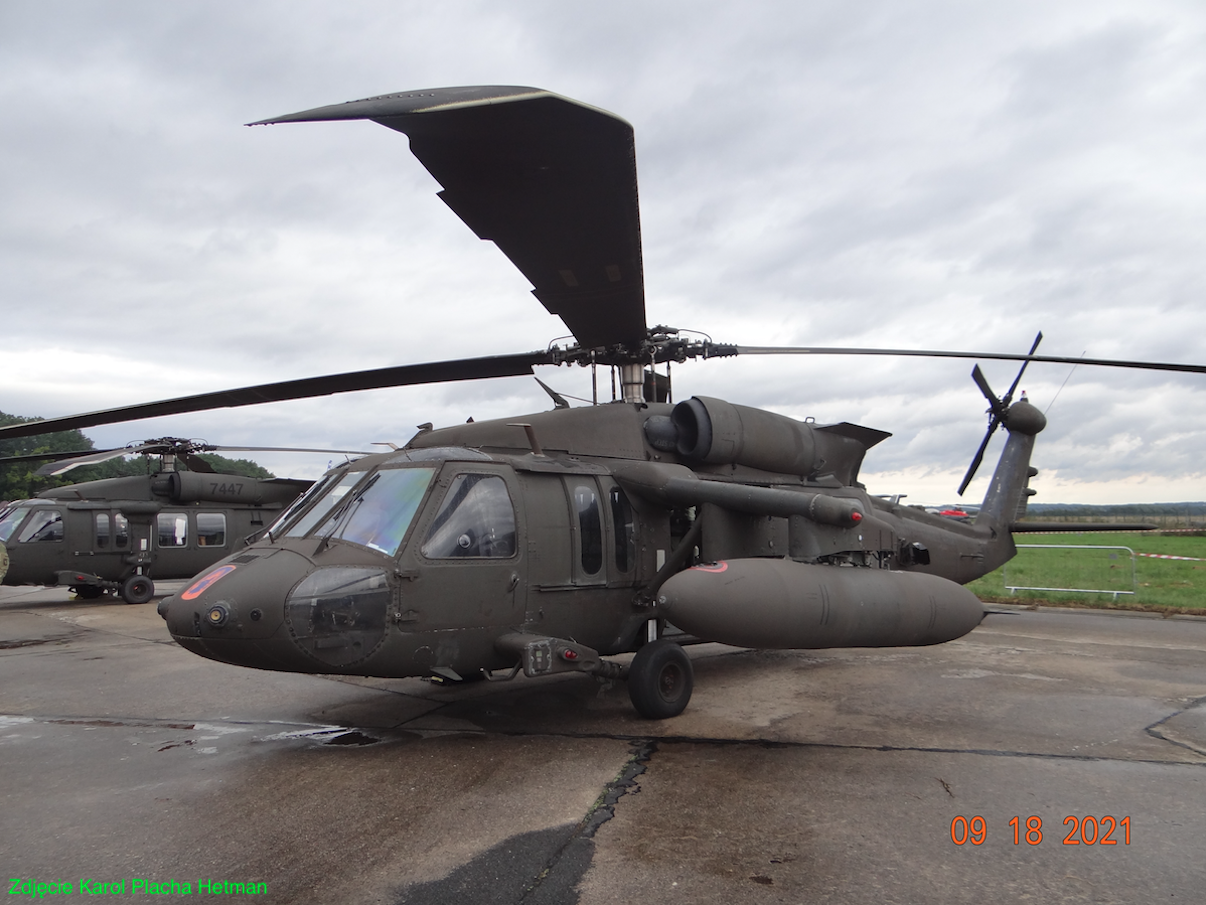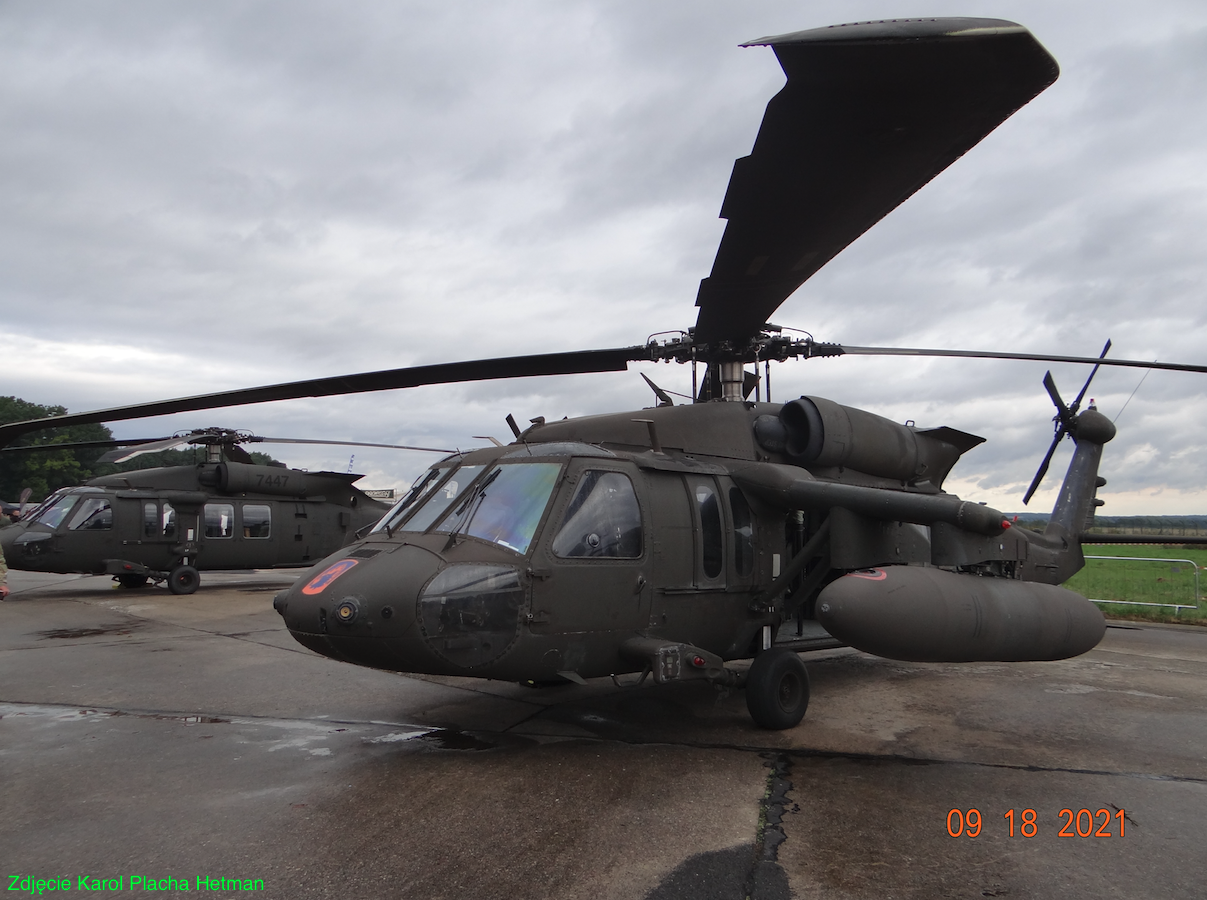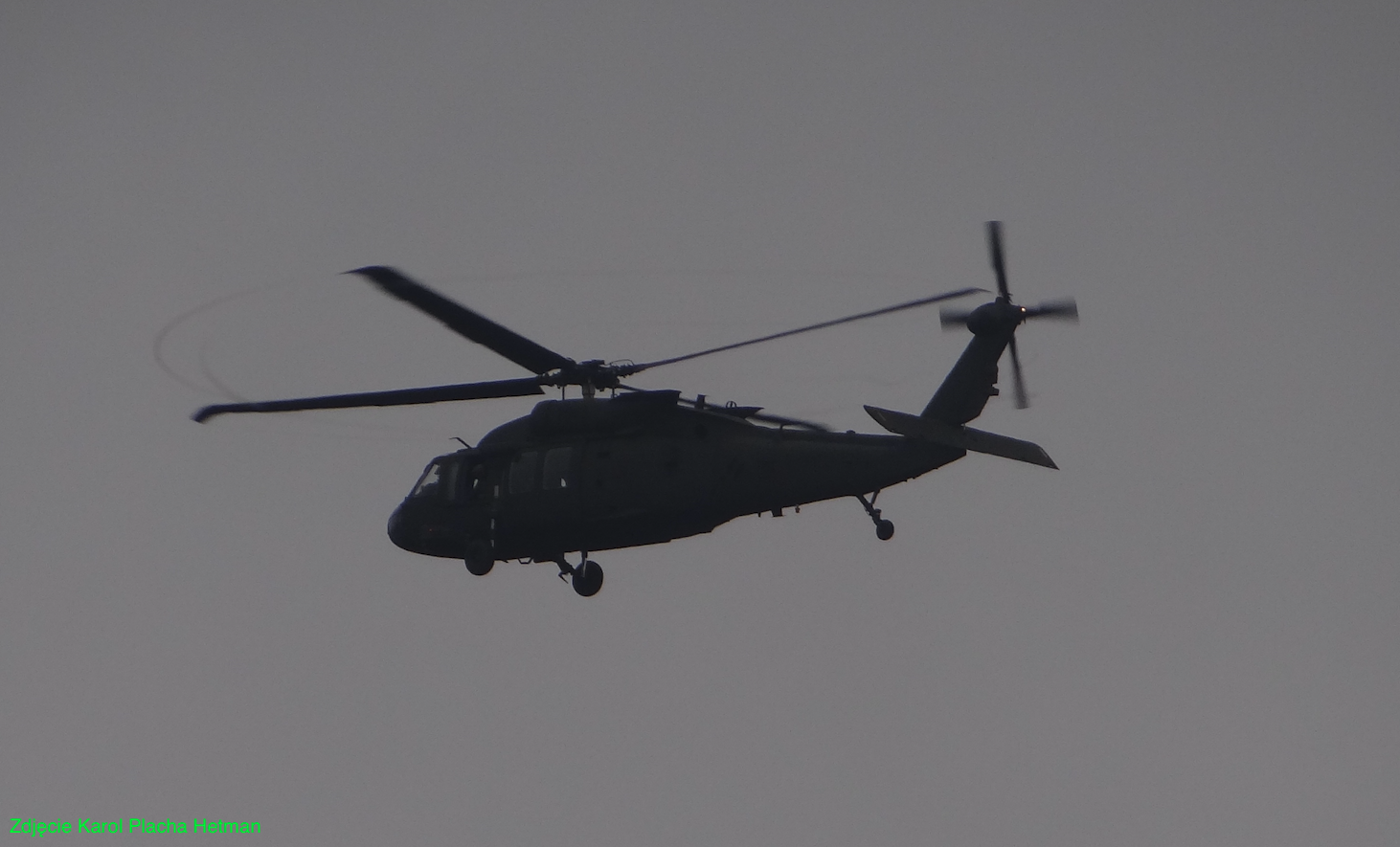Mielec 2012-04-19
Sikorsky-Mielec Black Hawk S-70i
317b Rozdział 15.03.2010 rok. Polska.
Konstrukcja S-70 / UH-60 Black Hawk.
Śmigłowiec S-70 / UH-60 Black Hawk zbudowany jest w układzie klasycznym – Sikorsky. Maszyna jest średnim, dwusilnikowym, całkowicie metalowym, śmigłowcem wielozadaniowym.
Płatowiec.
Płatowiec wykonany ze stopów aluminium z udziałem kompozytów (laminaty szklane i kevlar). Podłoga w kokpicie i ładowni wykonana z laminatu szklanego i nomexu. Także w belce ogonowej zastosowano kompozyty. Taka belka jest lżejsza o 10 % od tradycyjnej wykonanej wyłącznie z metalu.
Śmigłowiec został opracowany pod względem zwiększonej odporności na zgniecenie podczas upadku. Przy zderzeniu z ziemią z prędkością pionową 11,5 m/s i prędkością poziomą 12,2 m/s, struktura śmigłowca powinna zachować się w 85 %. Powinien wytrzymać przyspieszenie poziome 20 g i przyspieszenie pionowe 10 g.
Fotele załogi są opancerzone kewlarem. Wejście do kokpitu zapewniają drzwi typu samochodowego z lewej i prawej strony, o wysokości 1,37 m. Mogą być awaryjnie odstrzelone. Ładownia zabiera na pokład 11-14 w pełni uzbrojonych żołnierzy. Po demontażu środkowych siedzeń można zamontować 4-6 pary noszy lub ładunek. Ładownia jest ogrzewana i klimatyzowana. Dostęp do ładowni zapewniają duże przesuwane drzwi w lewej i prawej burcie, o wysokości 1,75 m. Śmigłowiec może zabrać na pokład haubicę 105 mm, 50 pocisków do niej i obsługę złożoną z 5 żołnierzy. Objętość kokpitu i ładowni to 10,90 m sześciennego.
System podwieszeń zewnętrznych o oznaczeniu ESSS składa się z kompletu zaczepów na stałe przytwierdzonych do kadłuba oraz czterech montowanych do nich wysięgników. Łączny udźwig podwieszeń zewnętrznych wynosi 4 536 kg.
Usterzenie pionowe to poszerzona końcówka belki ogonowej. W jego wnętrzu jest przekładnia pośrednicząca i przekładnia śmigła ogonowego umieszczonego z prawej strony.
Usterzenie poziome ma dużą powierzchnię o obrysie trapezowym i zmiennym kącie zaklinowana. Ma on duży zakres zmiany; od +34 stopnie (podczas zawisu) do -6 stopni (przy autorotacji). Jego system sterowania uwzględnia prędkość lotu śmigłowca oraz pochylenia i przyspieszenia boczne. Sterowanie jest zdwojone elektryczny i dodatkowo ręczne, mechaniczne.Część belki ogonowej jest składana do hangarowania na prawo.
Podwozie trójpodporowe z kołem ogonowym. Stałe. przednie, główne z potężnymi amortyzatorami firmy General Mechatronics. Pneumatyki kół podwozia głównego mają wymiary 26×10,00-11, zaś koła ogonowego 15×6,00. Rozstaw podwozia głównego: 2,70 m. Baza podwozia 8,83 m.
Wirnik nośny.
Wirnik nośny cztero-łopatowy o obrysie prostokątnym i profilu Sikorsky SC-1095 o grubości względnej 9,5 %. Szerokość łopat wirnika: 0,53 m. Środkowa część łopaty ma zwis krawędzi natarcia i klapę na krawędzi spływu dla pokonania zawirowań pochodzących od poprzedniej łopaty w locie poziomym. Kąt skręcenia łopaty wynosi 18 stopni. Końcówki łopaty skośne o kącie 20 stopni. Łopaty mają dźwigary o przekroju owalnym wykonane z tytanu. Spływ łopat wykonany w układzie ulowym z nomexsu z pokryciem z kompozytu epoksygrafitowego. Nasada łopaty wykonany także z kompozytu z włókien szklanych, dodatkowo pokryta osłoną z tytanu. Końcówki łopat wykonano z kevlaru. Łopata wytrzymuje przebicie pociskiem kalibru 23 mm. We wnętrzu łopata jest wypełniona gazem pod ciśnieniem i ma czujniki, które informują o trwałości struktury. Odladzanie krawędzi natarcia realizowane jest przy pomocy instalacji elektrycznej.
Elastomerowe łożyska głowicy wirnika nośnego firmy C/R Industries nie wymagają smarowania. W głowicy zamontowano tłumiki drgań. Głowica została tak zaprojektowana, aby można było ręcznie złożyć łopaty wirnika celem łatwiejszego hangarowania lub załadunku do samolotu transportowego. Średnica wirnika: 16,36 m (53 ft 8 cali).
Śmigło ogonowe.
Śmigło ogonowe cztero-łopatowe o podobnej budowie jak łopaty wirnika nośnego. Także odladzane elektrycznie. Jest umieszczone z prawej strony belki ogonowej. Pracuje jako śmigło ciągnące. Jego płaszczyzna odchylona jest od pionu w lewo o kąt 20 stopni. Dzięki temu wytwarza niewielki ciąg do góry co ułatwia wyważenie śmigłowca i pozwala na większą wędrówkę środka ciężkości. Średnica śmigła ogonowego: 3,35 m.
Przekładnia główna.
Przekładnia główna w układzie konwencjonalnym. Dwa turbinowe silniki z wolną turbiną przekazują napęd poprzez przekładnie planetarne i układ kół zębatych do wału głównego wirnika nośnego oraz na wał napędowy śmigła ogonowego. Przekładnia główna ma konstrukcje złożoną z pięciu modułów. Możliwa jest jej praca po całkowitej utracie oleju przez 30 minut. Głowica wirnika może być kilkanaście centymetrów obniżona w dół dla hangarowania lub przewozu samolotem.
Napęd.
Zespół napędowy składa się z dwóch silników turbinowe General Electric T700-GE-700 o mocy 2 x 1 151 kW. Wersja cywilna silnika ma oznaczenie General Electric CT-7-2C. Ich łączna moc przekazywana do przekładni wynosi 2 109 kW. Nowsza wersja to General Electric T700-GE-701 A o mocy startowej 2 x 1 285 kW. Typowy zespół napędowy: 2 × turbosprężarka General Electric T700-GE-701D, 1 409 kW (1,940 KM).
Budowa silnika: 5-stopni osiowych, 1-stopień promieniowy, pierścieniowa komora spalania, 2-stopniowa turbina, wolna turbina. Spręż 5:1, przepływ powietrza 4,5 kg/s przy obrotach 44 720 obr/min. Wolna turbina o prędkości obrotowej 17 000 – 21 000 obr/min. Silnik wykonano głównie ze stali nierdzewnej AM-355. Wymiary 1,181 m x 0,635 m x 0,584 m.
Silniki są od siebie znacznie oddalone co uniemożliwia zniszczenie ich obu jednym trafieniem. Dodatkowo mają między sobą przegrody ogniowe. Silniki są zdolne do pracy w ekstremalnych warunkach klimatycznych, wysoką wytrzymałość na środki ogniowe przeciwnika, prostą obsługę, niewielkie gabaryty w stosunku do osiąganej mocy. Silniki te są stosowane także w śmigłowcach bojowych AH-64 Apache.
Na wlotach powietrza można zamontować filtry pierścieniowe wychwytujące 85 % zanieczyszczeń powietrza: piasek i pył.APU – typu Solar T-62T-40-1. Układ rozruchowy silników firmy Garret. Można zastosować dodatkową instalacje do rozruchu silników w ekstremalnie niskich temperaturach.
Instalacja paliowa składa się z dwóch zbiorników umieszczonych za ładownią o łącznej pojemności 1 340 litrów. Zbiorniki mają dużą wytrzymałość na zgniecenie i są samouszczelniające. Możliwy jest montaż dodatkowych zbiorników w ładowni lub na wysięgnikach zewnętrznych.
Wyposażenie.
Instalacja elektryczna o napięciu 24/28 V. Generatory prądu firmy Bendix 30/40 kVA oraz 20/30 kVA. Akumulatory niklowo-kadmowe o pojemności 17 Ah. Instalacja przeciwpożarowa z gaśnicami zamontowanymi w przedziale napędowym i w kadłubie. Uruchamiana automatycznie lub ręcznie.
Awionika (stan na 1985 rok).
Radiostacje E-system AN/ARC-114 VHF-MF, Sylvania AN/ARC-114 UHF-AM, Magnavox AN/ARC-164 UHF-AM, Colins AN/ARC-186 VHF-AM/FM, transponder IFF Bendix AN/APX-100, system utajniania korespondencji radiowej Magnovox TSEC/KT-28, telefon pokładowy, radiokompas Emerson AN/ARN-89, odbiornik sygnałów radiolatarni Bendix AN/ARN-123, girokompas Sperry AN/ASN-128, wysokościomierz radiowy Honeywell AN/aPN-209, radiowy odbiornik ostrzegawczy Melpar-Memcor AN/APR-39, zestaw do obserwacji w podczerwieni Sanders AN/ALQ-144, automatyczny system sterowania lotem firmy Hamilton Standard z trój-osiowym pilotem automatycznym.
Dane T-T Black Hawk S-70i.
Załoga dwie osoby. Pojemność 14-17 miejsc / 12 żołnierzy / 6 noszy. Ładowność 4 072 kg (9 000 funtów). Długość 19,76 m (64 ft 10 in). Długość kadłuba 15,26 m. Długość po złożeniu łopat i belki ogonowej 12,60 m. Szerokość kadłuba 2,36 m. Rozpiętość statecznika poziomego 4,38 m. Wysokość całkowita 5,13 m. Średnica wirnika 16,36 m (53 ft 8 cali). Średnica śmigła ogonowego 3,35 m. Wysokość 5,33 m (17 ft 6 in). Masa własna 5 347 kg (11,790 lb). Masa startowa Maksymalna 9,979 kg (22 000 funtów). Paliwo wewnętrzne 1 360 litrów. Paliwo wewnętrzne zbiorniki 2 x 700 litrów, zbiornik 1 705 litrów (450 US gal) na pokładzie oraz 872 litrów (230 US gal) w zbiornikach na każdym z pylonów lub 1 705 litrów (450 US gal). Maksymalna prędkość 361 km/h (195 węzłów, 224 mph). Prędkość przelotowa 163 węzłów (301,8 km/h), maksymalny rejs (149 węzłów, normalny rejs). Zasięg 463 km, (288 mi, 250 nm) z rezerwą 20 min. Pułap użyteczny 6.096 m (20 000 ft). Prędkość wznoszenia 11,43 m / s (2,250 ft / m).
Uzbrojenie standardowe.
Broń: M240, MAG-58, M3M, Gau-19. Pociski rakietowe niekierowane: Hydra. Pociski rakietowe kierowane: Hellfire (x16).
Opracował Karol Placha Hetman



